{{ $t('Summary') }}
This Mercedes-Benz W201 190 E2.0L is a Cocoon Edition. The Cocoon edition is the final version of this iconic W201 series for the Belgian market, which was delivered in each motorisation at a quantity of 500 units. This Belgian car is sold on behalf of its 1st and only owner. It comes with a full maintenance history and proven mileage of 73.350 kilometers. The car is in fantastic condition both exterior and interior and is very well equiped: airconditioning, full leather interior, 8 speaker soundsystem, Becker GPS CD/radio, heatinsulating windows, central locking, electric windos, alloy wheels, etc.. A car in this condition and soon to be registered as oldtimer is very rare.

{{ $t('History') }}
The Mercedes-Benz W201 was the internal designation for the Mercedes 190 series sedans, a range of front-engine, rear drive, five passenger, four-door sedans manufactured over a single generation, from 1982 to 1993 as the company's first compact class automobile. Designed by Bruno Sacco, head of styling at Mercedes-Benz from 1975 to 1999, the W201 debuted at the 1982 Paris Motor show. Manufactured in both Bremen and Sindelfingen, Germany. The W201 introduced a 5-link rear suspension subsequently used in E and C class models, front and rear anti-roll bars, anti-dive and anti-squat geometry—as well as airbags, ABS brakes and seatbelt pretensioners. Its extensive use of light-weight high-strength steel enabled it to withstand a concrete barrier offset crash at 35 mph (56 km/h) without serious passenger injury or cabin deformation. The Cocoon version of the W201 was only delivered in Belgium from the end of 1992 to the beginning of 1993. The saloon came equipped with an option package including air conditioning, wood finish, leather interior, electric antenna and windows, metallic paint, wooden gear knob, radio-cd with 8 speakers and 8-loch LM wheels. A total of 500 'Cocoons' of each type were delivered. This example was registered on 11/09/1992. Its current and only owner has maintened the car as his child, as can be clearly witnessed from the photo's in the gallery.

{{ $t('Exterior') }}
This final-year example is finished in Black-Blue paint with matching body cladding. Features include an electric sunroof and a power antenna. All panels align perfectly, the paint and rubbers are still in original and excellent condition. Photos provided in the gallery below give a nice representation of the condition of the car. Factory 15″ alloy "8-hole" wheels are chrome-finished. A full-sized spare wheel and tire are mounted in the trunk.
{{ $t('Interior') }}
Almost like new. The interior features black full black leather comfort seats with matching black door panels, as well as a black dashboard and carpeting. Wood trim accents the center stack and console. Equipment includes power-adjustable front seats, cruise control, air conditioning, and an age correct Becker CD/GPS/Radio with 8 speaker sound. The four-spoke steering wheel is also in very good condition and sits ahead of a black dashboard. VDO instrumentation includes a 20-to-220-km/h speedometer with optional external temperature reading, an 7k-rpm tachometer, auxiliary gauges, and an analog clock. The odometer shows nearly 73.722k kilometers, which can be proven based on the extensive maintenance documentation set.

{{ $t('Engine and Gearbox') }}
The 2.0-liter inline-four with direct fuel injection, was factory rated at 120 horsepower when new. Power is sent to the rear wheels through a four-speed automatic transmission. Topspeed was 196 km/h.

{{ $t('Maintenance info') }}
The car has had a full mantenance at the end of 2021 in preparation of its sale.
{{ $t('Maintenance Documentation') }}
The maintenance and history documentation can be described in one word: complete. Stamped maintenance booklets and manuals, as well as invoices all can be found in the photogallery.
{{ $t('Options') }}
199u Blue Black - Metallic Paint 240 Outdoor Temperature Indicator 261A Black Leather / Anthracite 341 Additional Indicators 404 Multicontour Driver's Siege 405 Passenger Siege Multicontour 420 Automatic Transmission 444 Central Airbag 466 Central Closure 538 Automatic Antenna and Front Speakers - Without Radio 550 MERCEDES ORIGINAL REMOVABLE TOWBAR 580 AIR CONDITIONING 583 ELECTRIC WINDOW REGULATOR, DOUBLE 593 ALL ROUND HEAT INSULATED GREEN GLASS, HEATED REAR WINDOW, STRIP FILTER 620 EMISSION CONTROL SYSTEM 630 ECE WARNING TRIANGLE 652 8 HOLES 15 INCH ALLOY WHEELS 812 REAR SPEAKER 876 LIGHT ABOVE THE REAR WINDOW + RADIO CD GPS BECKER travel pilot (it works)

{{ $t('Known Issues') }}
No problems at all. Step in, start the engine and start driving for many years to come. The airconditioning system does require a refill to function fully correctly.
{{ $t('What we should know') }}
From January 1974 to January 1982, Mercedes spent over £600 million researching and developing the W201, subsequently saying it was 'massively over-engineered'. The company began testing early prototypes in 1978, with final styling approved on 6 March 1979. The first prototypes based on that design were tested later that year, with pilot production beginning in February 1982, following engineering sign-off. The W201-based 190 was unveiled on 8 December 1982, and launched in Germany on 9 December 1982. When difficulties prevented Daimler from manufacturing the W201 in Bremen, production began in Sindelfingen at a capacity of just 140,000 units per year. Bremen was subsequently cleared for W201 production, replacing the commercial production. The 190 E (E for Einspritzung, or Fuel Injection) model uses the Bosch KE-Jetronic Multi-Point Fuel Injection to meter fuel instead of the carburetor of 190 models. Thanks to their fuel injection system and larger intake and exhaust valves, 190 E models made more power than non-fuel injected 190 models.


